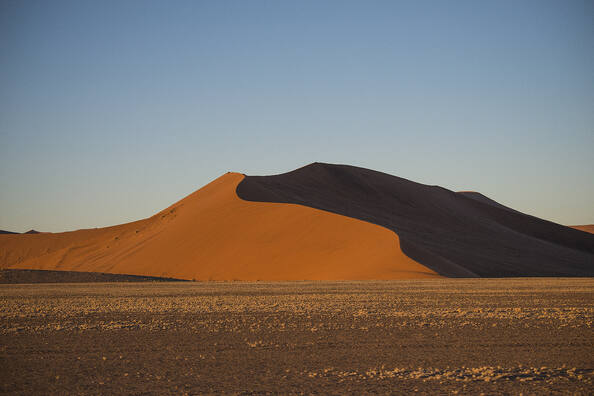Arenal de Namib
Namib Sand Sea
Namib Sand Sea is the only coastal desert in the world that includes extensive dune fields influenced by fog. Covering an area of over three million hectares and a buffer zone of 899,500 hectares, the site is composed of two dune systems, an ancient semi-consolidated one overlain by a younger active one. The desert dunes are formed by the transportation of materials thousands of kilometres from the hinterland, that are carried by river, ocean current and wind. It features gravel plains, coastal flats, rocky hills, inselbergs within the sand sea, a coastal lagoon and ephemeral rivers, resulting in a landscape of exceptional beauty. Fog is the primary source of water in the site, accounting for a unique environment in which endemic invertebrates, reptiles and mammals adapt to an ever-changing variety of microhabitats and ecological niches.
Description is available under license CC-BY-SA IGO 3.0
Erg du Namib
Le site qui s’étend sur plus de trois millions d’ha. - plus une zone tampon de 899 500 ha. - est le seul désert côtier où l’on trouve de vastes champs de dunes de sable sous l’influence du brouillard. L’Erg est composé de deux systèmes dunaires, un système ancien semi-consolidé sur lequel se superpose un système plus jeune et plus actif. L’endroit est exceptionnel car les dunes sont constituées de matériaux venus de loin, transportés depuis l’intérieur de l’Afrique australe par les cours d’eau, les courants océaniques et le vent. Le site comprend également des plaines de gravier, des cuvettes côtières, des collines rocheuses, des inselbergs à l’intérieur de l’erg, un lagon côtier, des cours d’eau éphémères, le tout formant un paysage d’une beauté exceptionnelle. Le brouillard est ici la principale source d’eau, contribuant à un environnement, unique à une telle échelle, où invertébrés, reptiles et mammifères endémiques s’adaptent à une grande variété de micro-habitats et de niches écologiques toujours changeantes.
Description is available under license CC-BY-SA IGO 3.0
Arenal de Namib
source: UNESCO/CPE
Description is available under license CC-BY-SA IGO 3.0
ナミブ砂海
霧が独自の生物を育む海岸砂漠。ナミビアの大西洋岸に広がり、霧に覆われた広大な砂漠や砂丘が見られる世界で唯一の海岸砂漠。川の流れや海流、風を介してアフリカ大陸内部から砂が運ばれ、現在も形成され続けているこの砂漠は、島状丘や平原、底の平らな窪地などの様々な地形が見られ、美しく広大であるとともに、風による砂と生物の相互作用の顕著な例である。砂漠環境に適応した特殊な固有の動植物が生息・生育しており、砂と風と霧により変化し続ける環境という極限状態での生物進化は無類のものとなっている。source: NFUAJ
Namibische zandzee
De Namibische zandzee is de enige kustwoestijn ter wereld die uitgestrekte duingebieden omvat die beïnvloed worden door mist. Het gebied – met een oppervlakte van meer dan drie miljoen hectare en een bufferzone van 899.500 hectare – bestaat uit een oud semigeconsolideerd duinsysteem bedekt door een jonger actief systeem. De duinen worden gevormd door het transport – via rivier, oceaanstroming en wind – van materiaal uit het achterland dat duizenden kilometers verderop ligt. De kustwoestijn bestaat uit gravelvlaktes, kustlaagtes, rotsachtige heuvels, inselbergs in de zandzee, een kustlagune en tijdelijke rivieren. De primaire bron van water in de woestijn is mist.
Source: unesco.nl
